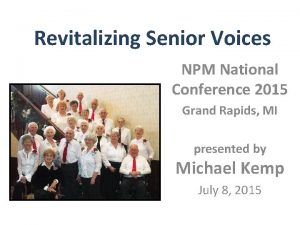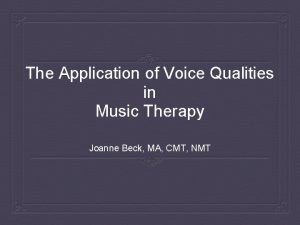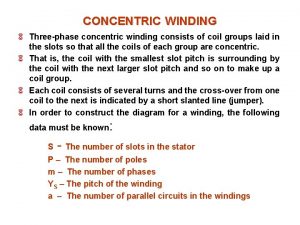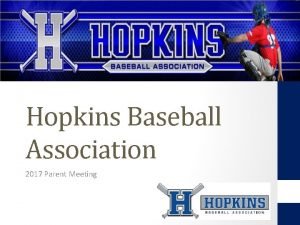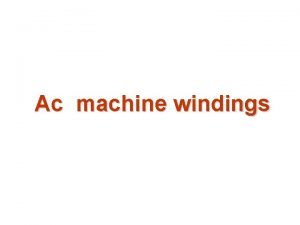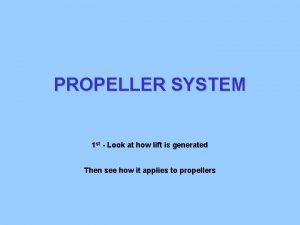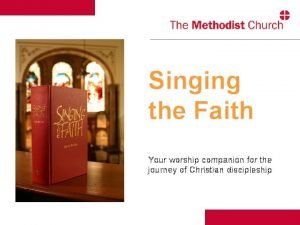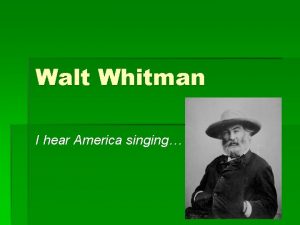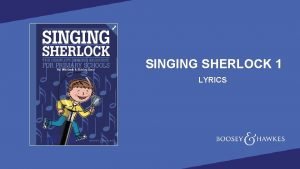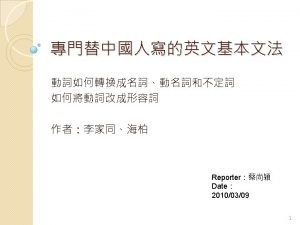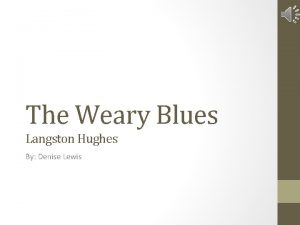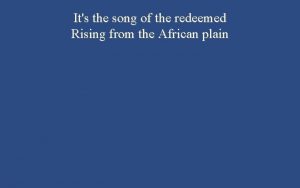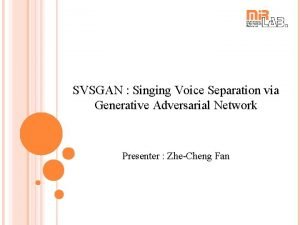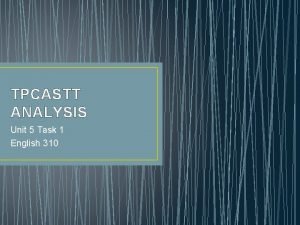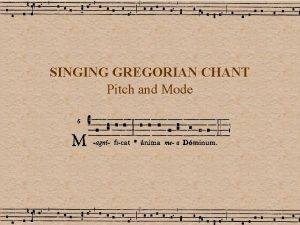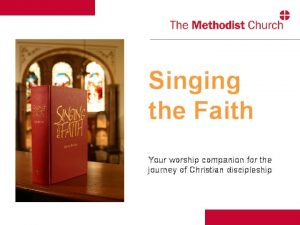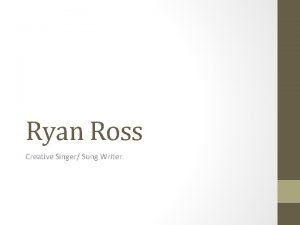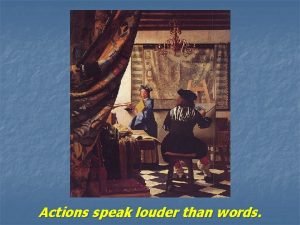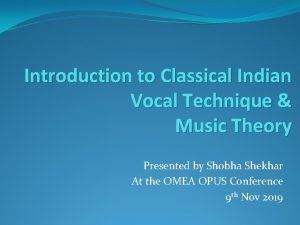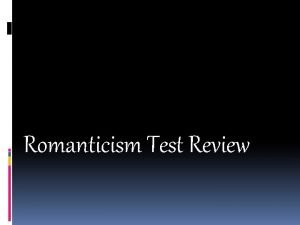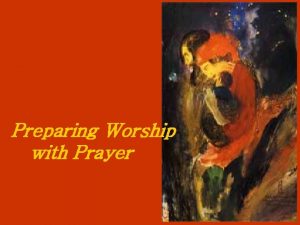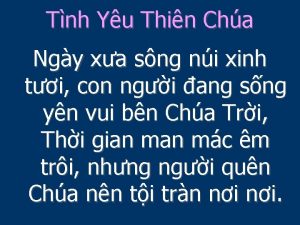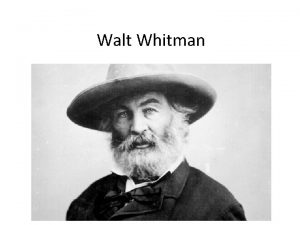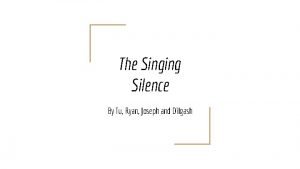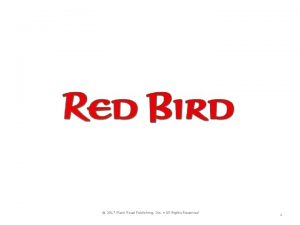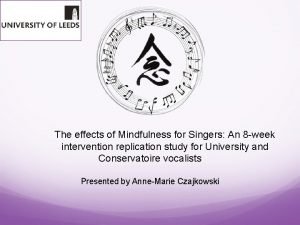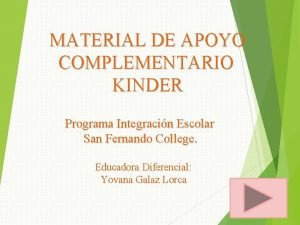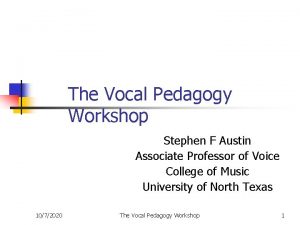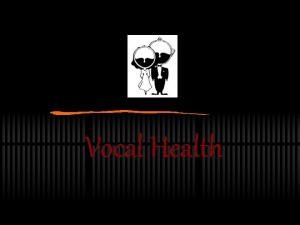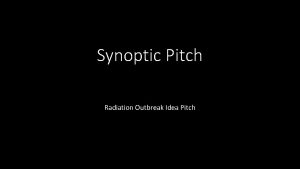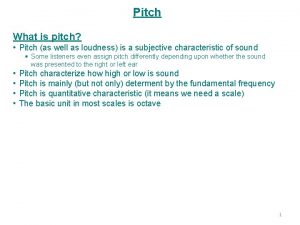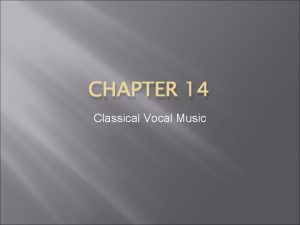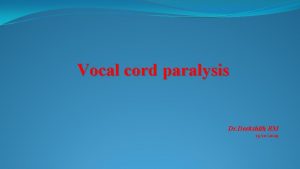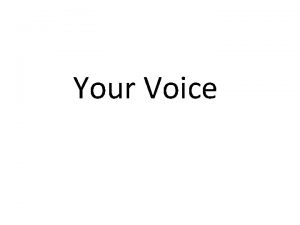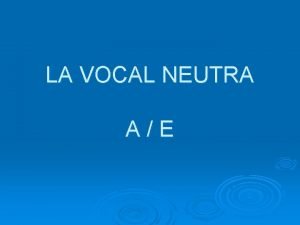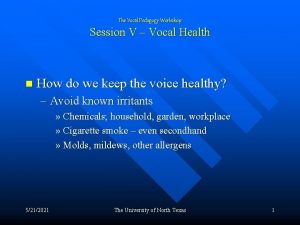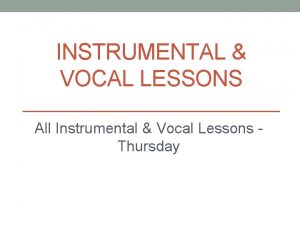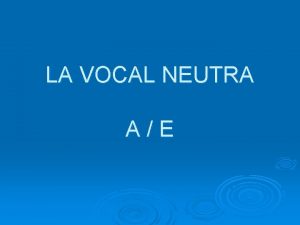NEURAL CORRELATES OF VOCAL PITCH REGULATION IN SINGING











































- Slides: 43

NEURAL CORRELATES OF VOCAL PITCH REGULATION IN SINGING JEAN MARY ZARATE Dept. of Neurology & Neurosurgery Mc. Gill University

INTRODUCTION ¡ Precise vocal pitch regulation necessary for speech and song ¡ Vocal pitch regulation requires integration between: l l l ¡ Stable vocal motor system Auditory feedback Interface between these two components not well-understood Used singing to find neural substrates for audio-vocal integration

Elicit learned vocalizations Initiate vocalizations

EXP 1: Experience-dependent neural substrates involved in vocal pitch regulation (Zarate & Zatorre, 2008) ¡ 12 non-musicians (6 ♀), 12 singers (6 ♀) ¡ HYPOTHESES: l SIMPLE: basic network for singing (Perry et al. , 1999) IGN: ↑ attention areas, ↓ auditory cortical activity COMP: audio-vocal integration = ACC, STG, insula? l Singers: l l Singing tasks: singers > non-musicians ¡ Experience-dependent modulation in basic network for singing, audio-vocal integration ¡

SIMPLE – PERC (SINGER ∩ NON-MUS) M 1 Cbl SMA Th STG/ INS PAC/ STG ACC 6. 1 y = -14 x=0 z=0 2. 5 IGN – SIMP (SINGER > NON-MUS) PT/ STG STS 4. 0 y = -22 2. 0 d. PMC 3. 7 z = 68 2. 0 SINGER > NON-MUS > SINGER COMP – SIMP (GROUP DIFF) p. STS RCZa 4. 4 x = -10 x = 50 2. 4

EXP 1: KEY FINDINGS ¡ IGN: non-mus had pitch-shift responses l l ¡ Pitch-shift response = vocal stabilization system Training needed to suppress stabilization Audio-vocal integration: ¡ Non-mus: d. PMC (sensorimotor association) ¡ Singers: RCZa, p. STS

EXPERIMENT 2: Neural networks involved in voluntary and involuntary vocal pitch regulation in experienced singers (Zarate et al. , submitted) ¡ ¡ 9 singers (6 ♀) SIMPLE; IGN/COMP 200 c and 25 c pitch shifts l l ¡ COMP 200 c = voluntary vocal pitch regulation Pitch-shift response in IGN 25 c = PAG? Unable to verify role of PAG due to temporal resolution limitations of f. MRI

FUNCTIONAL CONNECTIVITY: COMP 200 EFFECTIVE CONNECTIVITY: COMP 200 (vs. SIMPLE) p. STS seed EFFECTIVE CONNECTIVITY: IGN 200 (vs. SIMPLE) p. STS seed

¡ EXP 1 & 2: RCZa, p. STS, anterior insula l l l ¡ Recruited after vocal training Functionally connected to each other p. STS interacts with IPS to monitor feedback EXP 3: Training effects in non-musicians (Modulation of functional network for singing after auditory training) l l l Better auditory skills = better vocal accuracy? Better vocal accuracy modulations in singing networks Melodies: ¡ Singing tasks: 50 c & 100 c melodies, simple singing ¡ Perception: micromelody discrimination (<100 c interval)

FUNC. CONNECTIVITY (POST – PRE) right PT seed

EXP 3: CONCLUSIONS ¡ Short-term auditory training l l l ¡ training effects with micromelody discrimination no training effects on vocal production no neural modulations specifically induced by training-enhanced vocal production Dissociation between perceptual and production skills? l l different time-courses of behavioral improvement auditory-motor training necessary

¡ ¡ Consolidated after adequate audiovocal training Short-term auditory training does not engage or consolidate network

ACKNOWLEDGMENTS Robert J. Zatorre Advisory Committee: D. Louis Collins Alan Evans David Ostry Université de Montréal / BRAMS / CIRMMT: James Bergstra Douglas Eck Sean Wood Mc. Gill / MNI: Pierre Ahad Patrick Bermudez Marc Bouffard André Cormier Karine Delhommeau Michael Ferreira Nicholas Foster Talya Grumberg Funding: ¡ Canadian Institutes of Health Research (CIHR) ¡ Eileen Peters Mc. Gill Majors Fellowship ¡ Centre for Interdisciplinary Research in Music Media and Technology (CIRMMT) New York: Henry Mc. Donagh III Members of the Z-Lab

FUTURE DIRECTIONS ¡ A-V network specific to vocal pitch? l l manipulate other features (e. g. , formants) training effects: foreign language students MEG, EEG/ERP: pitch-shift response ¡ Auditory training vocal accuracy ¡ l l ¡ more testing sessions of vocal production longer auditory training Similar network with other perturbations? l somatosensory feedback

EXP 1: Audio-vocal integration SINGERS & NON-MUS EXP 2: Voluntary/involuntary vocal pitch regulation SINGERS EXP 3: Vocal pitch regulation after auditory training NON-MUS

¡ ¡ SIMPLE: Sing back single note PITCH-SHIFTED TASKS: ignore/compensate for ± 200 c-shift

IGNORE COMPENSATE

SIMPLE – PERC (SINGER ∩ NON-MUS) M 1 STG/ INS SMA Cbl Th PAC/ STG ACC 6. 1 x=0 2. 5 y = -14 z=0

IPS SMG 4. 2 y = -50 2. 0 SINGER > NON-MUS CONJUNCTION IGNORE - SIMPLE STS PT/ STG 4. 0 2. 0 y = -22

COMPENSATE – SIMPLE ACC IPS 3. 9 SMG 2. 0 y = -44 d. PMC 3. 7 z = 68 2. 0 SINGER > NON-MUS x=4 NON-MUS > SINGER CONJUNCTION r. ACC x = -10 p. STS 4. 4 2. 4 x = 50

EXP 1: Experience-dependent neural substrates involved in vocal pitch regulation (Zarate & Zatorre, 2008) ¡ Behavioral tasks: l l ¡ SIMPLE, IGN: singers > non-mus COMP: both groups successful Programmed to stabilize systems against disturbances Training needed to suppress stabilization mechanisms f. MRI results l l l SIMPLE: singers ≈ non-musicians COMP/IGN: ↑ auditory activity in singers Audio-vocal integration: ¡ Non-mus: d. PMC ¡ Singers: r. ACC, p. STS

IGNORE pitch-shift response Responses to long pitch shifts (>500 ms): – Early: ~100 -150 ms, more automatic – Late: ~300 ms, may be subject to voluntary control

EXPERIMENT 2: Neural networks involved in voluntary and involuntary vocal pitch regulation in experienced singers (Zarate et al. , submitted) ¡ ¡ 9 singers (6 ♀) SIMPLE; IGN/COMP 200 c and 25 c pitch shifts HYPOTHESES: l l Resp. magnitude: COMP 200 c > IGN 200 c Singers cannot suppress pitch-shift responses to small shifts: COMP 25 c = IGN 25 c IGN/COMP 200 c networks similar to exp 1 PAG pitch-shift response in IGN/COMP 25 c?




EXP 2: CONCLUSIONS ¡ Pitch-shift responses to IGN 25 c under less voluntary control than IGN 200 c l ¡ Role of PAG in pitch-shift response: not verified l l ¡ part of stabilization system occurs in milliseconds, f. MRI temporal resolution in seconds MEG, EEG/ERP: temporal interaction during A-V integration Voluntary vocal corrections: same network for different magnitudes: r. ACC, p. STS, anterior insula l l functionally connected to each other p. STS interacts with IPS to monitor shifted feedback

EXPERIMENT 3: Modulation of functional network for singing after auditory training (Zarate et al. , in prep) HYPOTHESES: l Auditory training with pure tones ¡ ↑ micromelody discrimination (pure- and vocal-tone) ¡ ↑ vocal accuracy l Melodic singing requires audio-vocal integration: ¡ similar regions seen in Exp 1, 2 ¡ auditory working memory (e. g. , inf. frontal) l Modulation of regions after training: ¡ singing network ¡ audio-vocal integration

• Perception: – 2 micromelodies: same/different? – Trained/tested with micromelodies (pure & vocal tones) • Production: simple singing & 5 -note melodies – Middle note ≈ 250 Hz – Intervals: 50 and 100 cents


EXP 3: ORDER OF TASKS beh pre Trained 9 subj (6 ♀) Control 10 subj (6 ♀) Production: ¡Simple ¡Melodies Perception: ¡Micromelod y discrimination f. MRI pre Production: ¡Simple ¡Melodies TRAINING f. MRI (2 weeks) post YES NO Production: ¡Simple ¡Melodies beh post Perception: ¡Micromelody discrimination Production: ¡Simple ¡Melodies




SIMPLE – PERC (PRE) SMA PAC / STG / PT INS sensorimotor (mouth) ACC 7. 8 2. 5 x=2 y = -16 z = 10 MEL(50+100) – SIMPLE (PRE) PT/STG 6. 6 2. 6 y = -12 z=4

POST – PRE


SCANNER PARAMETERS Exp 1 & 3: 1. 5 Tesla ¡ TR = 10 s, TE = 85 ms ¡ voxel = 5 mm 3 ¡ 25 slices (whole head) ¡ Matrix: 64 x 64 Exp 2: 3 Tesla, cardiac gating ¡ TR = 10. 3 s, TE = 60 ms ¡ voxel = 3. 5 mm 3 ¡ 40 slices (whole head) ¡ Matrix: 64 x 64

DUAL-STREAM MODEL OF AUDITORY PROCESSING ¡ Rauschecker/Tian 2000: l l Ventral: “what” – auditory object info Dorsal: “where” – auditory spatial info Belin/Zatorre 2000: Dorsal = “how” ¡ Warren et al. 2005: Dorsal = “do” ¡ ¡ Updated model: Dorsal = how / do

SINGING NETWORKS IN OTHER STUDIES

Hickok et al. 2003: covert speech vs. covert humming Schultz et al. 2005: voiced vs. whispered speech

Toyomura et al. 2007: COMP

EXP 1: PUTAMINAL ACTIVITY IGNORE - SIMPLE COMP - SIMPLE Put p. STS Put 4. 0 4. 4 2. 0 z = 10 2. 4 z=2
 Npm throat
Npm throat Similarities of vocal styles of india and israel
Similarities of vocal styles of india and israel True vocal folds and false vocal folds
True vocal folds and false vocal folds Correlates of effective schools
Correlates of effective schools Concentric winding
Concentric winding Hopkins baseball association
Hopkins baseball association Ac machine winding
Ac machine winding Cyclic pitch vs collective pitch
Cyclic pitch vs collective pitch How to calculate tube pitch in heat exchanger
How to calculate tube pitch in heat exchanger Back pitch and front pitch
Back pitch and front pitch Helix angle of propeller
Helix angle of propeller Regulation of breathing
Regulation of breathing Singing the faith
Singing the faith I hear america singing walt whitman
I hear america singing walt whitman Knickerbocker number 9 lyrics
Knickerbocker number 9 lyrics Glory glory hallelujah he reigns
Glory glory hallelujah he reigns What type of conflict does lily face in this excerpt?
What type of conflict does lily face in this excerpt? I like singing
I like singing Theme of the weary blues
Theme of the weary blues It's the song of the redeemed
It's the song of the redeemed Singing
Singing Angels singing to shepherds
Angels singing to shepherds Tpcastt i hear america singing
Tpcastt i hear america singing Plan prodaje primer
Plan prodaje primer Boy singing
Boy singing Podatus gregorian chant
Podatus gregorian chant I'm singing for my lord everywhere i go lyrics
I'm singing for my lord everywhere i go lyrics Singing the faith plus
Singing the faith plus Ryan ross singing
Ryan ross singing Ruby green singing painting
Ruby green singing painting Indian singing technique
Indian singing technique I hear america singing romanticism
I hear america singing romanticism Singing praise
Singing praise Holy holy are you lord
Holy holy are you lord Ngày xưa sông núi xinh tươi
Ngày xưa sông núi xinh tươi Walt whitman transcendentalism
Walt whitman transcendentalism The singing silence
The singing silence Sing fly
Sing fly Red bird singing from the old pine tree
Red bird singing from the old pine tree They do not appreciate my singing
They do not appreciate my singing Before you spoke a word
Before you spoke a word Singing teacher
Singing teacher Objetos con vocal a
Objetos con vocal a Vocal
Vocal
